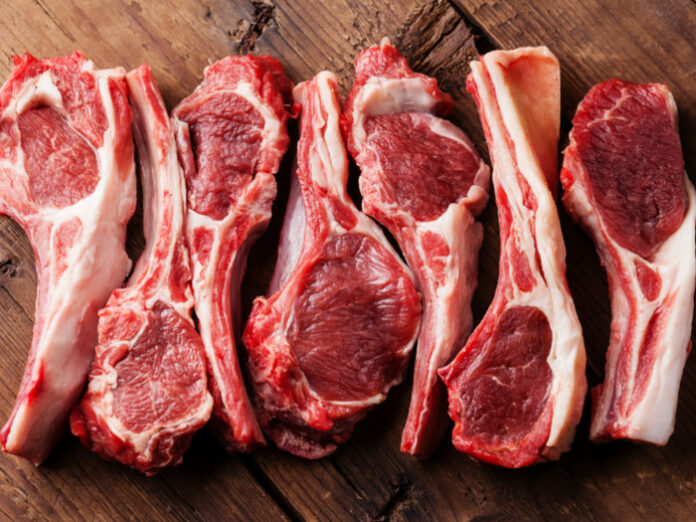Aside from the nutrient profile, lamb has many other nutritional benefits.
Here are ten good reasons to eat lamb.
- Lamb Contains L-Carnosine
The Molecular Element For L-Carnosine.
L-Carnosine is a compound that contains two amino acids (proteins) bonded together; beta-alanine and histidine.
Only certain foods contain carnosine in high amounts, and lamb is one of these.
Per 100 grams, lamb contains – on average – 400mg of carnosine, which is slightly higher than beef (365mg).
L-Carnosine’s Health Benefits
Firstly, carnosine is classed as a non-essential nutrient because our bodies can make it internally.
However, recent research is showing that higher amounts of carnosine from external sources may offer additional health benefits.
Among these, carnosine appears to have anti-atherosclerotic effects, meaning that it may help to protect against cardiovascular disease.
Notably, carnosine also helps to reduce the glycation of sugars and proteins in our body.
Glycation leads to the formation of advanced glycation end products (AGEs).
Unfortunately, AGES are harmful compounds which directly cause inflammation and oxidative stress, and they are believed to be one of the keys to the aging process.
Key Point: Lamb is among the best dietary sources of carnosine, a healthy compound that may have powerful health-protective properties.
- Lamb is a Significant Source of Complete Protein
One of the biggest positives from eating lamb is the protein content.
Lamb is extremely rich in protein, and depending on the cut it contains anywhere between 25 – 30 grams per 100 grams.
While it is common knowledge that lamb is an excellent source of protein, not all protein is made the same.
In other words; the efficiency by which our body can use protein differs depending on the specific food and the amino acids it contains.
On the positive side, lamb contains every amino acid, and we can, therefore, class it as a ‘complete’ protein.
This completeness means that our body can use lamb protein more efficiently than ‘incomplete’ proteins in plant foods.
Protein is incredibly important for our health, and it encourages lean muscle mass, the growth and repair of cells, and higher levels of satiety.
Key Point: Lamb contains a significant amount of high-quality protein.
- Lamb Is Incredibly Nutrient Dense
While some people like to judge food based on how many calories it contains, the caloric load says little about the food’s relative health merits.
The best measurement of the health properties of a particular food is nutrient density.
Lamb passes the nutrient-density test with flying colors, and here is a quick summary of why;
Lamb contains large amounts of healthy fat, including more omega-3 than most land animals and high levels of oleic acid.
High concentrations of bio-available, highly digestible protein.
A substantial amount of vitamins and minerals; particularly B vitamins and zinc.
A range of beneficial compounds including creatine, glutathione, conjugated linoleic acid, carnosine and taurine.
- A Surprising Source of Omega-3 Fatty Acids
In the modern world, most people are consuming too much omega-6 and not enough omega-3. This issue is important because omega-3 fatty acids have an anti-inflammatory effect, while omega-6 is pro-inflammatory.
Providing these two essential fatty acids are relatively balanced, they are both useful and beneficial. However, some people are now eating a diet that is approaching 20:1 in favor of omega-6 to omega-3.
Removing omega-6 vegetable oils such as soybean oil is a great way to change this. Additionally, consuming omega-3 fatty acids from seafood (especially oily fish) helps us to get more omega-3.
However, land animals can also be rich in omega-3.
This is especially the case for animals raised on pasture. As one such animal, lamb tends to be an excellent source of omega-3.
In pasture-raised lamb, the levels of omega-3 are higher than grain-finished animals.
As an example, 100 grams of grass-fed lamb rib contains 580 mg of omega-3 and 750 mg of omega-6; nearly a 1:1 ratio (18).
Key Point: Lamb meat – especially pasture-raised – is rich in omega-3 fatty acids.
- An Important Source of Heme Iron
A Diagram Showing the Structure For the Molecular Compound Heme.
Many different foods contain iron and it is present in everything from spinach and kale to bananas and tomatoes.
However, just as the digestibility of protein differs, not all iron is made the same.
When it comes to digestion and absorption, heme iron is king.
In fact, we can absorb approximately 15-35% of heme iron (found in animal foods), but this absorption rate drops to 10-15% for non-heme sources of iron (plant foods).
It is unfortunate to see the rise of iron-deficiency anemia.
Over the period between 2004 and 2013, iron-deficiency anemia rates in the US population nearly doubled to 5.6%. During the same decade, red meat consumption fell by 19%.
Importantly, lamb contains a rich source of heme iron in amounts similar to other red meat such as beef.
- Lamb Contains a Significant Amount of Creatine
Creatine will be well known to anyone with interest in working out and/or sporting performance.
Markedly, creatine can help to boost muscular endurance, strength and – potentially – muscle mass.
While creatine supplements are very popular, this compound also occurs naturally in various foods.
Red meat is the most substantial dietary source of creatine and lamb contains approximately 300-500 mg per 100 grams.
Although this is not close to the same level as creatine supplement dosages (3 – 5 grams per day), it should still have a physiological benefit – especially for those eating higher amounts of lamb and beef.
Key Point: Lamb contains beneficial amounts of creatine, a compound that can help to improve sporting performance.
- Lamb is a Source of the “Master Antioxidant” Glutathione
A Diagram Showing the Chemical Formula For Glutathione.
People often refer to glutathione as “the master antioxidant” because of the critical role it plays in protecting our health and our internal antioxidant defense systems.
We cannot read too much into this since there is no clinical research on humans, but higher glutathione levels track with a longer lifespan in animal studies.
Notably, our body makes the glutathione compound internally from the amino acids cysteine, glutamic acid and glycine.
However, research suggests that consuming more exogenously (from outside sources; i.e. food) could have advantages.
On this note, a further health benefit of lamb is that it contains glutathione.
Also, it contains all three amino acids that our body requires to synthesize glutathione internally.
Key Point: Lamb contains glutathione and it also provides all the essential prerequisites for our body to make its own glutathione.
- Lamb Contains Conjugated Linoleic Acid (CLA)
Lamb contains a source of the natural trans-fatty acid CLA.
Firstly, don’t worry about the name ‘trans fat’ because the naturally occurring version found in animal foods is much different from synthetic trans-fat.
In fact, it may even have some health benefits.
For instance, a meta-analysis of 18 controlled trials demonstrates that supplementing with isolated CLA “produces a modest fat loss in humans”.
Furthermore, research shows that people with higher tissue levels of CLA have a reduced risk for myocardial infarction (heart attack).
However, correlation does not necessarily equal causation. To illustrate this point, the people with higher levels of CLA were likely consuming more meat and dairy (and probably less refined carbohydrate).
In other words, it is difficult to pinpoint precisely what is lowering the risk.
Either way, lamb meat is richer in CLA than any other meat and contains approximately 4 – 19.0 mg CLA per gram of fat content.
By comparison, beef typically contains 1.2 – 4.0 mg while pork and poultry contain less than 1.0 mg (32).
Key Point: Lamb is the single biggest dietary source of CLA.
- A Source of Healthy Fats
A Fatty Cut of Fresh Lamb Meat Steak On a Tray.
These kinds of ‘health benefit’ lists generally do not mention fat.
After years of health authorities demonizing dietary fat, that is not really a big surprise.
However, let’s give fat the credit it deserves; good fat is an essential and healthy part of the human diet.
Furthermore, two specific fatty acids in lamb are very beneficial for us;
Omega-3: Lamb meat from animals raised on pasture has similar levels of anti-inflammatory omega-3 fatty acids as some fish.
Oleic acid: This monounsaturated fatty acid is one of the most evidence-based fats and it is widely known as the “heart healthy” fat in olive oil. Research consistently links oleic acid to lower levels of inflammation and better health markers.
- Lamb is Tasty!
This one is not really a health benefit, but it is always challenging to enjoy supposedly “healthy” (flavorless) low-fat products.
On the other hand, lamb genuinely is nutrient-dense and a healthy food. It is doubtful that anyone would complain about the taste of it.
Put simply; lamb is one of the tastiest (and healthiest) foods in the world.
Source: www.nutritionadvance.com









